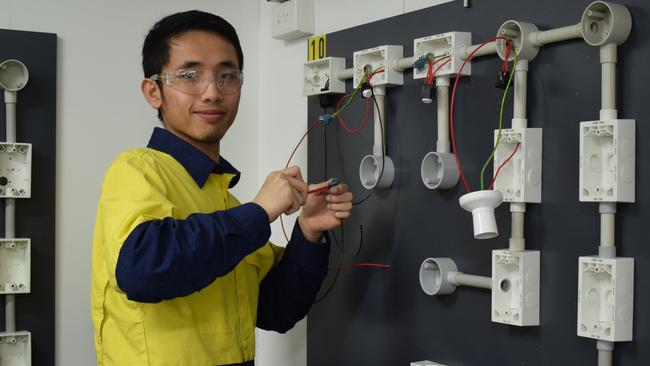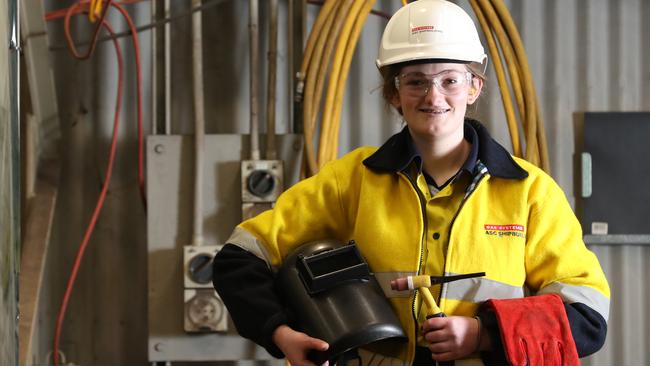How to trade university for vocational education to get a good job and salary
Many Aussie parents worried that their children will not get a good job after high school. But there are ways young people can get into the workforce.
Careers
Don't miss out on the headlines from Careers. Followed categories will be added to My News.
- Sign up to the Australian National Talent Registry to get work
- The most in-demand workers in Australia
Too many school students still are being pushed into university despite equal or better career outcomes from vocational education and training.
The plight of vocational careers, typically seen as tradies but also encompassing jobs in sectors ranging from health to IT, has continued to decline in the past decade, with a university degree still seen as the preferred pathway to get a successful career.
However, the federal government’s Education, Skills and Employment department forecast pre-COVID-19 that there would be more job openings in the five years to May, 2024, for people who did not hold university qualifications (590,400) than those who did (486,400).
Meanwhile, National Centre for Vocational Education Research statistics show 91.5 per cent of apprentices and 85 per cent of trainees were employed full or part time after finishing their training in 2019, compared with 86.8 per cent of bachelor degree graduates.

The median starting salary for vocational education and training (VET) graduates in full-time work in 2019 was lower than their university-educated counterparts, but only slightly, at $59,100 compared to $62,600.
Federal government figures show it takes university graduates an average of nine years to pay back their HECS debts but National Skills Week chair Brian Wexham says apprentices and trainees get paid to train.
“An apprentice carpenter, for instance, would have earned around $120,000 at the completion of a four-year apprenticeship, as opposed to the average university student who completes a degree with little or no practical work experience and with up to a $30,000 or higher HECS debt,” Wexham says.
He also says taking a VET pathway first does not prohibit students from pursuing university later.
“Further, if students complete a qualification while at school and decide they do want to go to university, their training may be accredited towards their education, meaning they may
become qualified faster,” he says.
Isabella Veritay-Richards is on her way to a naval shipbuilding career before she has finished Year 12.
She is undertaking a school-based apprenticeship this year, attending TAFE to learn boilermaker skills as she works at BAE Systems Australia/ASC Shipbuilding.

“I love that I can do this apprenticeship while still completing my SACE,” she says.
“I am the sort of person who likes to do practical based work.
“An apprenticeship gives me the opportunity to develop my skills in these areas and build a career for my future in a dynamic and growing industry.
“I believe there will be endless opportunities following the completion of my apprenticeship to expand my career at BAE Systems Australia/ASC Shipbuilding and I can’t wait to look at a completed project and know that I contributed to something so important.”
The benefits for vocational graduates do not just last in the year after finishing their training.
Almost as many trades and services jobs (13,669) are being advertised this week on SEEK as healthcare and medical roles (14,049), both surpassing the third most-advertised sector of IT, in which there are 8724 advertised vacancies.
National Apprentice Employment Network chief executive Dianne Dayhew says skilled trades will be an important part of the nation’s economic recovery from COVID-19 as governments invest in infrastructure projects.
“If young people are looking for employment opportunities post-COVID, certainly the ones that require skilled trades will be a big focus,” she says.
“It has been a problem … attracting young people to trades.
“There used to always be a cohort of people who would go to uni or go into the trades for whatever reason.
“In more recent years, the trades have been considered as a second option.”
MORE NEWS
How to make a job application stand out in a competitive job market
What lies ahead for tradies beyond their apprenticeship
School-based apprentices give young people an edge over their peers
Dayhew urges young people to choose their career path based on long-term employment outcomes and work environment.
“There needs to be a real considered focus for young people – what pathways do I take that will lead to employment, and is there demand in that sector?” she says.
“What kind of lifestyle do I want? Where do I want to live? Do I want to travel in my career?
“Trades are something you can take with you everywhere, all around the world.
“I know in my street, all the biggest houses are built by people who are tradies – they get the best cars and the biggest houses because they are focused on building their wealth from a young age.”
National Skills Week runs this week to raise awareness of the diverse careers that can be kickstarted through vocational education and training.
(note to sub: please keep this pointer in) SkillsOne has launched the free digital showcase called Skills and Thrills for parents to learn about vocational education and training pathways and success stories.
To access the 25-minute video, visit skillsone.com.au/digital-parents-showcase-subscription
Originally published as How to trade university for vocational education to get a good job and salary


